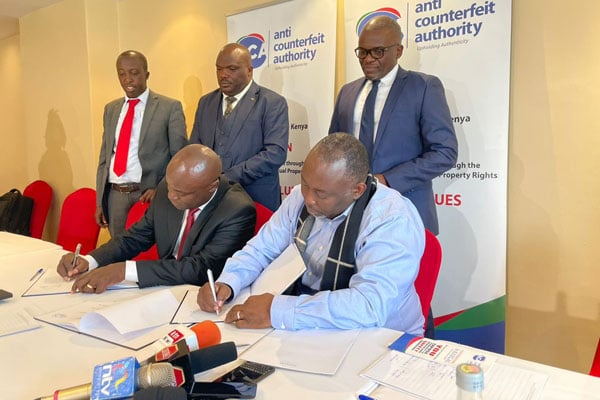Prime
Do more to get rid of counterfeits

Kenyan counterfeit Authority officials sign an MOU with Directors of the Anti- Counterfeit Network - Africa recently.
What you need to know:
- The issue: Counterfeits
- Our view: Governments should work to strengthen intellectual property protection by providing better legal frameworks and systems for businesses to protect their trademarks, copyrights, and patents.
In an effort to fight counterfeits in the East African region, the Anti-Counterfeit Authority of Kenya (ACA) and Uganda’s Anti-Counterfeit Network (ACN Africa) have signed a Memorandum of Understanding (MoU).
The agreement signed on April 20, in Kenya’s capital Nairobi aims at strengthening strategic collaboration on matters pertaining elimination of fake goods in East Africa.
The World Economic Forum estimates that illicit trade presently deprives the global economy of $2.2 trillion annually, accounting for nearly three percent of global gross domestic product (GDP).
Whilst the ACN revealed that Uganda loses up to Ugandan Shs6 trillion to counterfeits and substandard products every year, a 2018 ACA survey showed the value of counterfeit trade to be close to Kenyan Sh100 billion in revenue in 2018, a figure economists say could be more and increasing each year. This MoU is a good step in the right direction.
Additionally, both governments should strengthen the enforcement of existing laws and regulations that impose stricter penalties on individuals and organisations involved in the production, distribution, and sale of counterfeit goods. This can deter counterfeiters from engaging in these activities and help law enforcement agencies to take more effective actions against them.
Also, governments should increase the capabilities of their law enforcement agencies by providing them with more resources and training to detect, investigate, and prosecute counterfeiting cases. This can include hiring more personnel, using advanced technologies, and collaborating with other law enforcement agencies both domestically and internationally.
There should be efforts to raise awareness among the public about the dangers of counterfeit goods, including the potential health and safety risks they pose, and encourage consumers to only buy goods from reputable sources.
Strengthening intellectual property protection is another way to fight counterfeits. Governments should work to strengthen intellectual property protection by providing better legal frameworks and systems for businesses to protect their trademarks, copyrights, and patents. This can help discourage counterfeiters from attempting to replicate these items in the first place.
Last but not least, there should be coordination with international partners. As already indicated, counterfeiting is a global issue and it is important for governments to work together to combat it. Various governments can coordinate to share information, intelligence, and best practices, as well as conduct joint operations against counterfeiters operating across borders.


